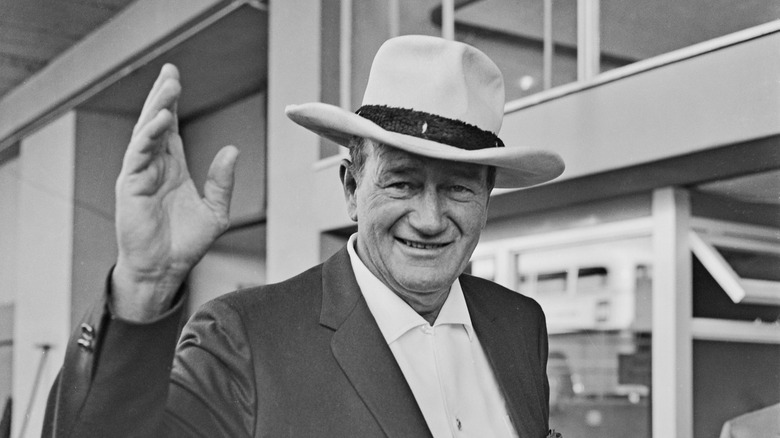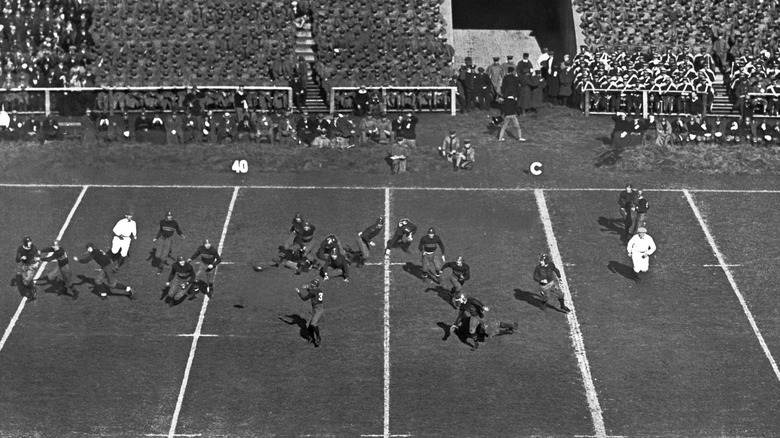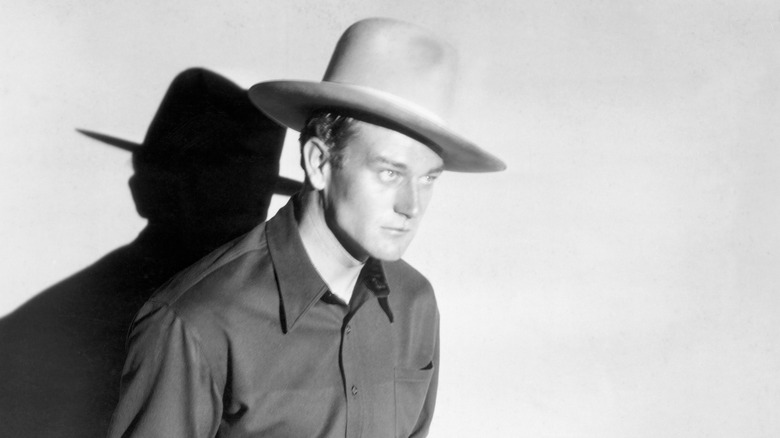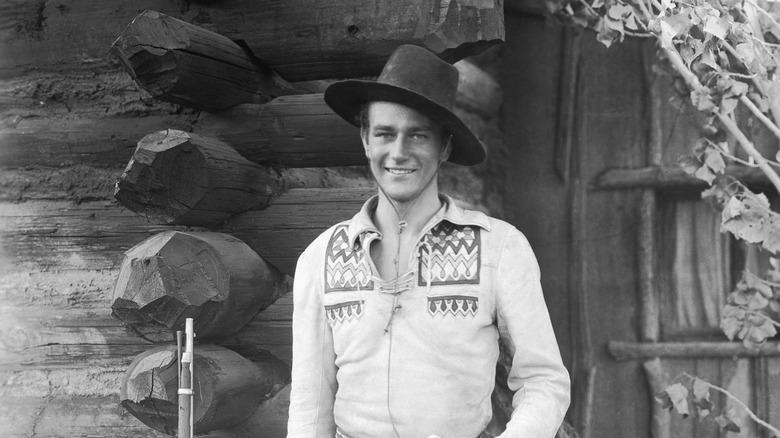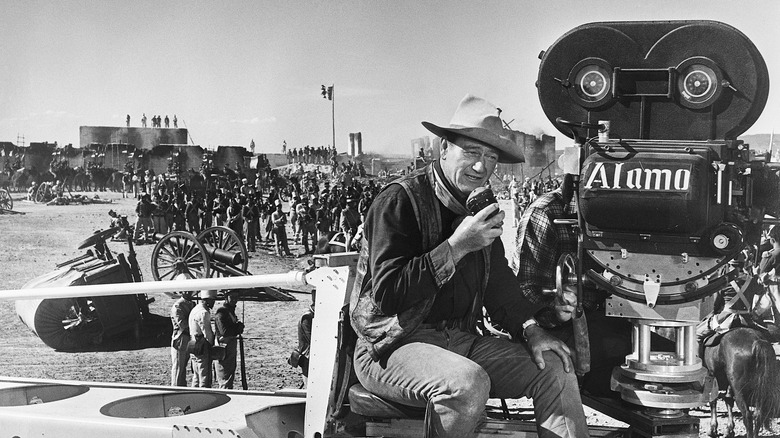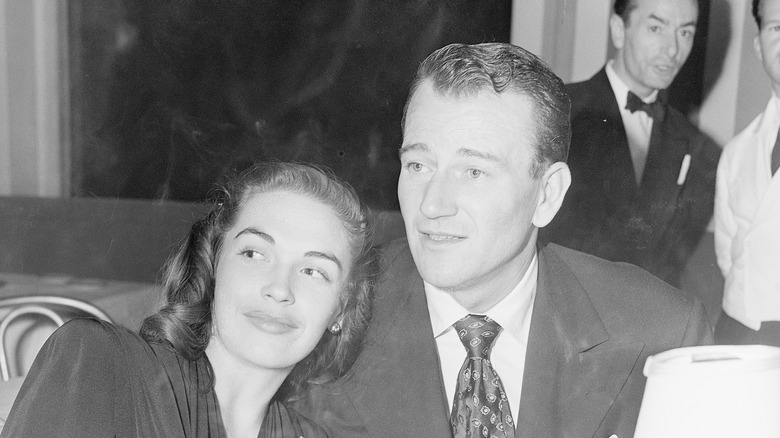John Wayne's Biggest Failures That Everyone Forgets About
When Hollywood legend John Wayne's name comes up, failure probably isn't the first word you think of. After all, the actor and producer had a long and renowned film career starring in such classics as "Stagecoach," "The Man Who Shot Liberty Valance," and "True Grit," for which he earned an Academy Award. By the time he died in 1979, he'd accrued the equivalent of $25 million in today's terms, which his seven children and first wife inherited.
Even so, as one of his biographers, Randy Roberts, pointed out in 1995, the Duke had his fair share of defeats, losses, and missteps over the years. "Three failed marriages, he lost two fortunes, his first big break was a failure, 10 years on Poverty Row — just one failure after another, and he just kind of kept going," Roberts told the Gannett News Service. Wayne was in college when he experienced his first great failure on the football field after suffering a shoulder injury.
He was a football failure
John Wayne was born Marion Morrison in May 1907 in Iowa before moving to California with his family as a child. He grew up working class, did well in school (especially in sports), and earned a football scholarship to the University of Southern California. But during his junior year he suffered a shoulder injury showing off for some female USC students by body surfing in rough waves.
A few days later back at USC, the varsity football coach, Howard Jones, noticed Wayne wasn't using his right shoulder to block tackles. "Jones accused the Duke of being yellow, of being afraid to block, and demoted him to the scrubs," Eugene Clark, a college friend of Wayne's, recalled in "John Wayne: The Life and Legend." Wayne was heartbroken. He lost his football scholarship and had to drop out of school. The loss left him scrambling for money to pay off school bills and live off of.
His rocky Hollywood start
John Wayne began working at the Fox studio in the props department as a summer job when he was in college. But by 1927 it was all he had going for himself along with a smattering of small film roles. Then in 1930, director Raoul Walsh — who gave Marion Morrison the stage name John Wayne — cast him as the lead in the western "The Big Trail." It was a grueling shoot filmed in 15 locations scattered across California, Arizona, Utah, Oregon, Montana, and Wyoming. But this extravagant Hollywood production with a cast of thousands seemed like it would make Wayne a big star.
Then the film came out. It fizzled at the box office. It had been shot in a new widescreen format that most movie theaters outside of Los Angeles and New York City couldn't afford to accommodate, meaning most moviegoers saw a less stunning version of the film. "The Big Trail" was Wayne's last big picture for almost a decade after Fox axed the star vehicles it had begun lining up for him.
Wayne was relegated to B-movie roles
After the fiasco of "The Big Trail," John Wayne's star dimmed significantly. Fox, where he was under contract, put him in a few B-films before unceremoniously giving him the boot when his contract was up in 1931. As the United States suffered through the Great Depression Wayne found himself without a job. Columbia Pictures eventually gave him a contract, but a rumor that the actor had become involved with a woman the studio's head, Harry Cohn, was romantically interested in led to another career stumble. Cohn took revenge on Wayne by casting him in B-movies, including one role where the Duke played a corpse, before canceling his contract.
Because of this, John Wayne nearly quit Hollywood. He spent most of the decade working in more than 60 low budget films, many for bottom-feeding film companies on what was termed Poverty Row. Worse, for most of that time, the man Wayne considered a friend, director John Ford, refused to cast him in any of his films and treated him with a cruel indifference. The actor looked up to Ford and couldn't understand why he had seemingly abandoned him. "Every young man finds an older man to look up to," Wayne told Merv Griffin in a 1970 television interview. "He was kind of like a big brother," he later added.
He had many financial failures
Then, John Ford cast John Wayne in his 1939 western "Stagecoach," which turned the tide and made him a star. As the Duke became famous he earned millions. Then, in 1959, he learned his financial manager, Bo Roos, had lost his fortune in bad investments, including in a bankrupt shrimp company. All Wayne had left was his house, his production company, and some worthless property. Roos was also broke, leaving the actor with no recourse to recoup his losses. "Roos cost me the first 20 years of my career," Wayne recalled in "John Wayne: The Man Behind the Myth." "I'd worked for 20 years for nothing."
The next year, Wayne directed, produced, and starred in the film "The Alamo." He plunged whatever of his own funds he had left into the film's production — the equivalent of around $9 million in today's terms — including money from a second mortgage on his house. While the film did well, Wayne's finances remained rocky. Then, on the heels of Roos' disastrous mismanagement, the actor allowed his son-in-law, Don LaCava — who had no experience — to handle his money. Just five years later, in 1965, Wayne was again broke, and he fired LaCava, who hadn't done much better than Roos. The Duke eventually got back on solid financial ground.
His failed marriages
John Wayne once asked a friend, Louis Johnson, why he seemed to have so much trouble with his relationships. "Louis, I can get along with everybody," he said via "John Wayne: American." "Why the hell can't I get along with women?" John Wayne's wives would likely have answered that he cheated on them, for starters. Wayne had three failed marriages. His first, to Josephine Saenz, lasted from 1933 to 1945 and produced four children. Throughout this time, Wayne had a long-running affair with fellow Hollywood legend Marlene Dietrich, among others.
Wayne's second marriage, to Mexican actress Esperanza Bauer, was even stormier. He was still married to his first wife when they got together. The couple's union lasted from 1946 to 1954. They fought often, and in 1947, Bauer, believing Wayne was having an affair with a co-star, drunkenly shot at him with a pistol, but missed. He met his third wife, Pilar Palette — 21 years his junior — when they were both still married. They wed in 1954 and had three children. Wayne allegedly had an affair with actress Maureen O'Hara during his third marriage, and while he and Palette never officially divorced, they separated in 1973. The Duke then moved in with his former secretary, Pat Stacy. Wayne may be best remembered for his many triumphs during his long Hollywood career, but he experienced nearly as many failures as well.
